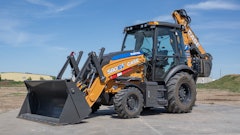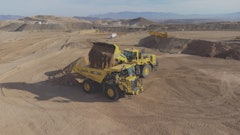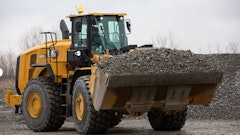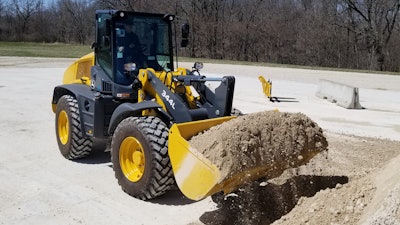
Contrary to what its names suggests, John Deere’s 344L wheel loader with Articulation Plus actually articulates less. The 103-hp loader machine owes its tighter turning radius and full-turn tip load of 12,677 pounds to a remarkably simple rear-wheel steer system unique to compact loaders.
“Most machines go to 40 degrees articulation, ours goes to 30 degrees,” explains Drew Miller, product marketing manager, compact wheel loaders, John Deere Construction & Forestry. “We kept the counterweight further away from the load and then gave the machine rear-wheel steer to help compensate. In so doing, we achieve a tighter turning radius and more tip load.
“With less articulation, and more rear-wheel steer, you get much more stability as you come out of a pile,” Miller continues.
The Cat 914M and Volvo L50H loaders offer sharp competition to the 344L’s tipping capacity, and the Volvo will turn a circle just 20 inches larger than Deere’s all-wheel steer machine. To get another brand that matches its 29-foot-7-inch turning circle, you’d have to settle for significantly less tipping capacity.
Get’r done
Miller points out that each of the three main design objectives for the 344L – maneuverability, ability and stability – owes something to rear-wheel steer.
“The mechanical linkage actuates off the articulation,” explains Miller. “It’s a simple design which stays low-cost because it requires little maintenance, with only two grease points.”
A pair of long tie rods connect the front frame to steering arms on the ends of the rear axle. When the machine articulates, the angle of the front frame provides the input to angle the rear wheels up to 10 degrees.
Deere has a supply agreement for the 344L with Liebherr, which has been building what they call the all-wheel-steer “Stereoloader” for more than 20 years. The 344L is powered by the Deere 4045 Final Tier 4 engine rated at 106 gross/103 net horsepower. It’s the largest of five models in John Deere’s compact line, three of which offer Articulation Plus.
What else is new?
The 344L is built for speed as well as maneuverability, traveling at up to 25 mph, thanks to smooth auto-shift technology. The transmission is hydrostatic, for infinitely variable speed choices, but auto-shifting between two speed ranges extends the loader’s transport range.
“One of the ways we were able to get up to 25 mph is by integrating a two-speed mechanical gearbox,” Miller explains. “We developed software for the gearbox that increases smoothness of shifts for less operator fatigue and improved material retention.”
Rim pull control extends tire life by allowing customers to adjust torque at the wheels to control slip and tire wear as jobsite conditions change.
The loader’s Z-bar boom and bucket linkage was redesigned for the L Series.
“We’ve improved the overall lifting capacity with a redesign that also gets to parallel lifting,” Miller says, noting there are only six degrees of rollback from the bottom to the top of the lift path.
“This minimizes the need for the operator to make adjustments mid lift,” he says. “It lets the operator focus on what he’s doing and not worrying about the machine. When you get to minimal rollback, it takes away any need for parallel-lift linkage.”
A new coupler casting is designed with strategically located holes to improve the operator’s view to the load on pallet forks. Operators can lift heavier loads and can keep more material on the forks or in the bucket with fewer fine adjustments.
The cab is completely redesigned with a larger windshield for better views to the work. And the air conditioning gear was moved outside, behind a service panel accessible from the ground.
A third-function “mini joystick on a joystick” is intended to improve precise control of auxiliary hydraulic functions.
Redesigned engine compartment
Ease of service was another factor in the design of the 344L. John Deere redesigned the rear engine compartment to create diagonal air flow across the engine. Cool air comes in above the rear wheel, goes across the engine and out the back of the machine.
“This helps with the amount and quality of air coming in,” Miller explains. “It’s not drawing in turbulent air off the top of the machine, and it’s not taking in as much dirt as it would if air was being drawn from the back of the machine.” Less dirt means less wear and tear on the engine.
“Serviceability is huge in rental,” Miller adds. “We’ve focused on ease of access and tried to bring all service points to ground level. Also, the cooling package is outside with its own door, same for the hydraulic tank fill.
Reversing fan capabilities keep machines in areas with lots of airborne debris running cooler, longer.
Finally, JDLink telematics provides real-time data and health prognostics to suggest maintenance solutions that decrease costly downtime. Remote diagnostics enable a dealer to read codes, record performance data and even update software without a trip to the jobsite.

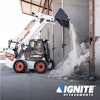


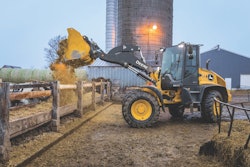









![Hcm Ax Landcros Dual Branded Logo[25]](https://img.forconstructionpros.com/mindful/acbm/workspaces/default/uploads/2025/11/hcmaxlandcros-dual-branded-logo25.Qhg3vUCjoK.jpg?ar=16%3A9&auto=format%2Ccompress&bg=fff&fill-color=fff&fit=fill&h=135&q=70&w=240)

